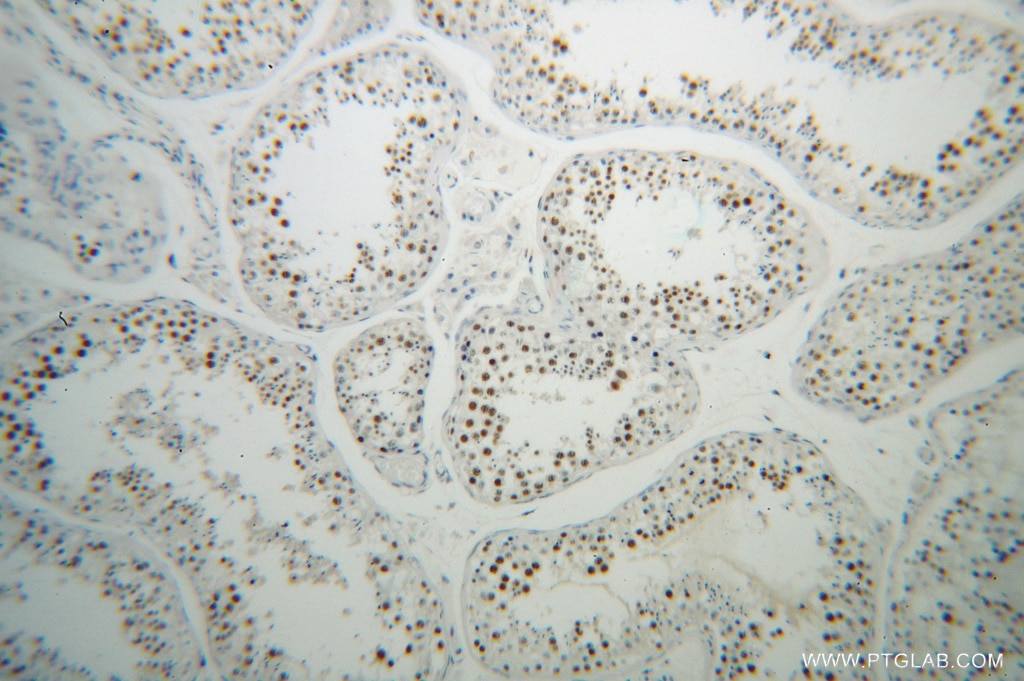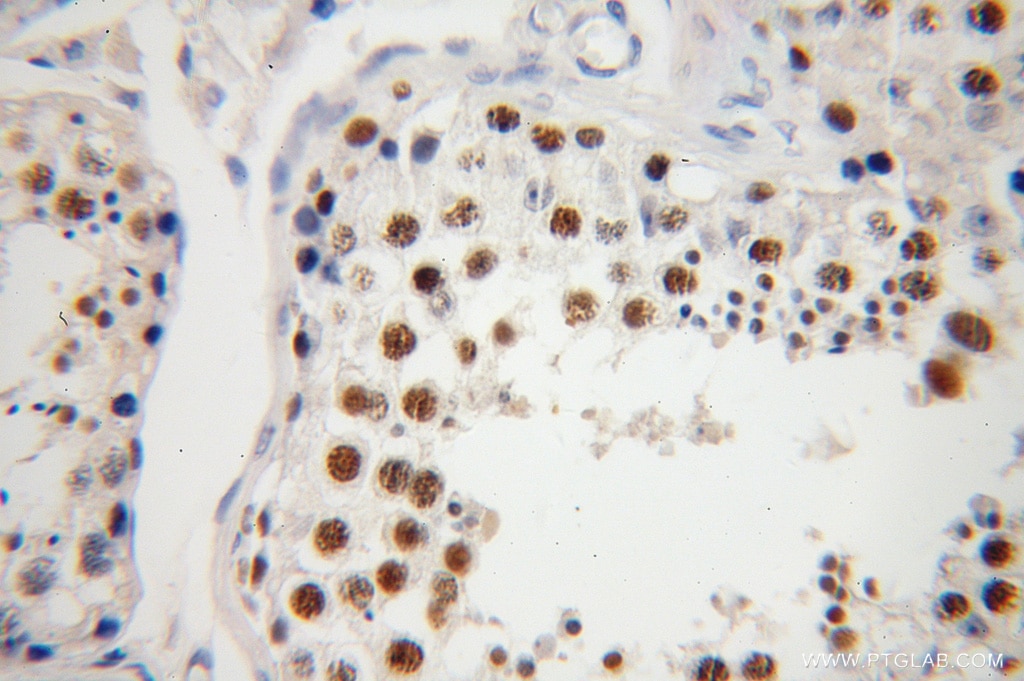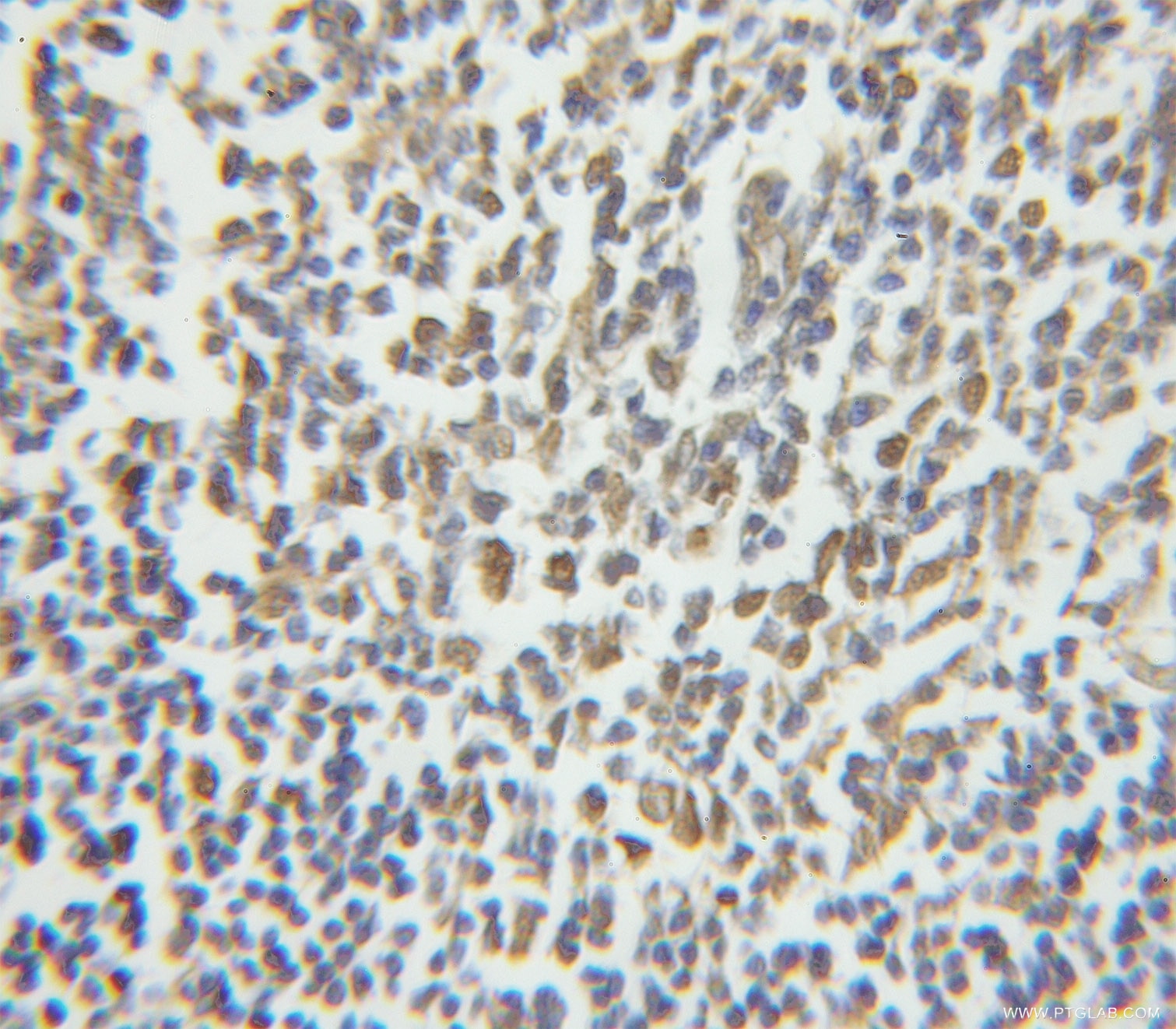Tested Applications
| Positive WB detected in | mouse testis tissue |
| Positive IP detected in | mouse testis tissue |
| Positive IHC detected in | human testis tissue, human lymphoma tissue Note: suggested antigen retrieval with TE buffer pH 9.0; (*) Alternatively, antigen retrieval may be performed with citrate buffer pH 6.0 |
| Positive IF/ICC detected in | MCF-7 cells |
Recommended dilution
| Application | Dilution |
|---|---|
| Western Blot (WB) | WB : 1:500-1:2400 |
| Immunoprecipitation (IP) | IP : 0.5-4.0 ug for 1.0-3.0 mg of total protein lysate |
| Immunohistochemistry (IHC) | IHC : 1:20-1:200 |
| Immunofluorescence (IF)/ICC | IF/ICC : 1:10-1:100 |
| It is recommended that this reagent should be titrated in each testing system to obtain optimal results. | |
| Sample-dependent, Check data in validation data gallery. | |
Published Applications
| KD/KO | See 1 publications below |
| WB | See 11 publications below |
| IHC | See 2 publications below |
| CoIP | See 1 publications below |
Product Information
11323-1-AP targets NASP in WB, IHC, IF/ICC, IP, CoIP, ELISA applications and shows reactivity with human, mouse, rat samples.
| Tested Reactivity | human, mouse, rat |
| Cited Reactivity | human, mouse, rat |
| Host / Isotype | Rabbit / IgG |
| Class | Polyclonal |
| Type | Antibody |
| Immunogen |
CatNo: Ag1824 Product name: Recombinant human NASP protein Source: e coli.-derived, PGEX-4T Tag: GST Domain: 439-788 aa of BC010105 Sequence: VDTKVAQGATEKSPEDKVQIAANEETQEREEQMKEGEETEGSEEDDKENDKTEEMPNDSVLENKSLQENEEEEIGNLELAWDMLDLAKIIFKRQETKEAQLYAAQAHLKLGEVSVESENYVQAVEEFQSCLNLQEQYLEAHDRLLAETHYQLGLAYGYNSQYDEAVAQFSKSIEVIENRMAVLNEQVKEAEGSSAEYKKEIEELKELLPEIREKIEDAKESQRSGNVAELALKATLVESSTSGFTPGGGGSSVSMIASRKPTDGASSSNCVTDISHLVRKKRKPEEESPRKDDAKKAKQEPEVNGGSGDAVPSGNEVSENMEEEAENQAESRAAVEGTVEAGATVESTAC Predict reactive species |
| Full Name | nuclear autoantigenic sperm protein (histone-binding) |
| Calculated Molecular Weight | 788 aa, 85 kDa |
| Observed Molecular Weight | 150 kDa, 70 kDa |
| GenBank Accession Number | BC010105 |
| Gene Symbol | NASP |
| Gene ID (NCBI) | 4678 |
| RRID | AB_2151166 |
| Conjugate | Unconjugated |
| Form | Liquid |
| Purification Method | Antigen affinity purification |
| UNIPROT ID | P49321 |
| Storage Buffer | PBS with 0.02% sodium azide and 50% glycerol, pH 7.3. |
| Storage Conditions | Store at -20°C. Stable for one year after shipment. Aliquoting is unnecessary for -20oC storage. 20ul sizes contain 0.1% BSA. |
Background Information
NASP (nuclear autoantigenic sperm protein) is associated with DNA replication, cell proliferation and cell cycle progression through functioning as a Histone H1 binding protein that mediates histone transport to the nucleus. NASP had two isoforms, tNASP (testis type) and sNASP (somatic type). The tNASP was mainly expressed in testis, a variety of malignant tumors, stem cells and embryonic tissues, while sNASP existed in all somatic mitosis cells. This antibody can recognize both isoforms.
Protocols
| Product Specific Protocols | |
|---|---|
| IF protocol for NASP antibody 11323-1-AP | Download protocol |
| IHC protocol for NASP antibody 11323-1-AP | Download protocol |
| IP protocol for NASP antibody 11323-1-AP | Download protocol |
| WB protocol for NASP antibody 11323-1-AP | Download protocol |
| Standard Protocols | |
|---|---|
| Click here to view our Standard Protocols |
Publications
| Species | Application | Title |
|---|---|---|
Genes Dev The death-associated protein DAXX is a novel histone chaperone involved in the replication-independent deposition of H3.3. | ||
Nat Struct Mol Biol The program for processing newly synthesized histones H3.1 and H4.
| ||
J Cell Sci Role of Template Activating Factor-I as a chaperone in linker histone dynamics. | ||
J Biol Chem MicroRNA-29a inhibited epididymal epithelial cell proliferation by targeting nuclear autoantigenic sperm protein (NASP). | ||
J Proteome Res Proteomic and Phosphoproteomic Analysis of Right Ventricular Hypertrophy in the Pulmonary Hypertension Rat Model | ||
Int J Nanomedicine Docetaxel-loaded solid lipid nanoparticles suppress breast cancer cells growth with reduced myelosuppression toxicity. |














